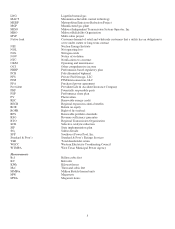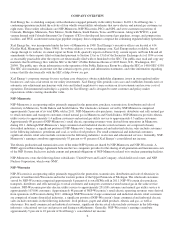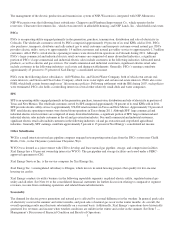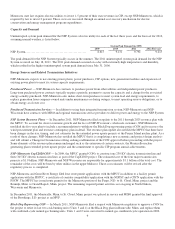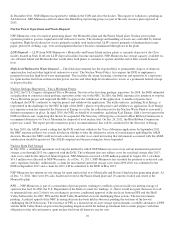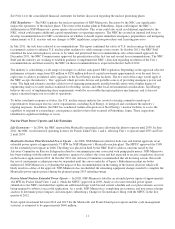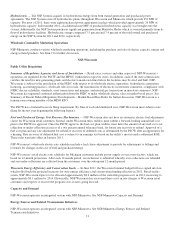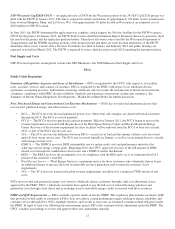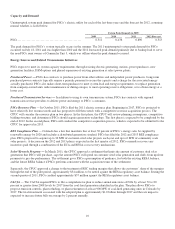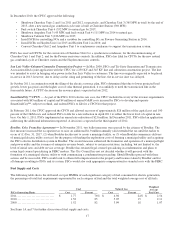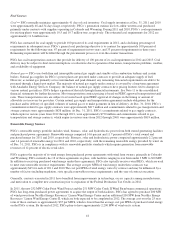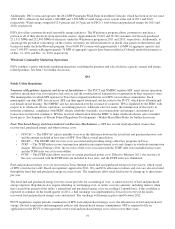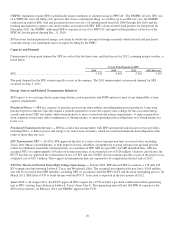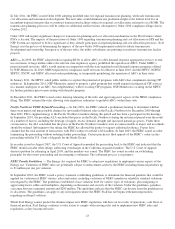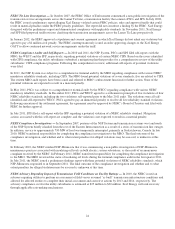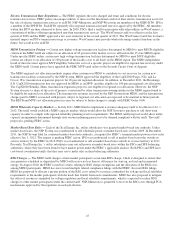Xcel Energy 2011 Annual Report Download - page 25
Download and view the complete annual report
Please find page 25 of the 2011 Xcel Energy annual report below. You can navigate through the pages in the report by either clicking on the pages listed below, or by using the keyword search tool below to find specific information within the annual report.15
NSP-Wisconsin CapX2020 CPCN — An application for a CPCN for the Wisconsin portion of the 345 KV CapX2020 project was
filed with the PSCW in January 2011. This line is expected to entail construction of approximately 150 miles of new transmission
lines between Hampton, Minn. and La Crosse, Wis. with approximately 50 miles located in Wisconsin at an estimated cost of
$200 million to NSP-Wisconsin.
In June 2011, the PSCW determined the application was complete, which triggers the 360-day deadline for the PSCW to grant a
CPCN for the project. In January 2012, the PSCW Staff issued a final Environmental Impact Statement that raises questions about
the need for the project and the applicants preferred routes. There have also been issues raised by the Wisconsin Department of
Transportation and the WDNR regarding portions of the proposed route and there are route location alternatives if the PSCW
determines these issues warrant such a decision. Testimony was filed in January and February 2012 and public hearings are
expected to be held in March 2012. The PSCW is expected to issue a final decision in mid-2012 regarding the transmission line.
Fuel Supply and Costs
NSP-Wisconsin operates an integrated system with NSP-Minnesota. See NSP-Minnesota Fuel Supply and Costs.
PSCo
Public Utility Regulation
Summary of Regulatory Agencies and Areas of Jurisdiction — PSCo is regulated by the CPUC with respect to its facilities,
rates, accounts, services and issuance of securities. PSCo is regulated by the FERC with respect to its wholesale electric
operations, accounting practices, hydroelectric licensing, wholesale sales for resale, the transmission of electricity in interstate
commerce, compliance with NERC electric reliability standards and natural gas transactions in interstate commerce. See
Summary of Recent Federal Regulatory Developments - Market-Based Rate Rules for further discussion.
Fuel, Purchased Energy and Conservation Cost-Recovery Mechanisms — PSCo has several retail adjustment clauses that
recover fuel, purchased energy and other resource costs:
• ECA — The ECA recovers fuel and purchased power costs. Short-term sales margins are shared with retail customers
through the ECA. The ECA is revised quarterly.
• PCCA — The PCCA recovers purchased capacity payments. Effective January 2011, the PCCA began to recover the
revenue requirement associated with the purchase of the Blue Spruce Energy Center and Rocky Mountain Energy
Center. Recovery of the revenue requirement for these facilities will be removed from the PCCA to base rates in mid
2012, as part of the PSCo electric rate case.
• SCA — The SCA recovers the difference between PSCo’s actual cost of fuel and the amount of these costs recovered
under its base steam service rates. The SCA rate is revised annually in January, as well as on an interim basis to coincide
with changes in fuel costs.
• DSMCA — The DSMCA recovers DSM, interruptible service option credit costs and performance initiatives for
achieving various energy savings goals. Beginning 2010, the CPUC approved recovery of the full amount of DSM-
related costs through the combination of base rates and a DSMCA tracker mechanism.
• RESA — The RESA recovers the incremental costs of compliance with the RES and is set at its maximum level of 2
percent of the customer’s total bill.
• Wind Energy Service — Wind Energy Service is a premium service for those customers who voluntarily choose to pay
an additional charge to increase the level of renewable resource generation used to meet the customer’s load
requirements.
• TCA — The TCA recovers transmission plant revenue requirements and allows for a return on CWIP outside of rate
cases.
PSCo recovers fuel and purchased energy costs from its wholesale electric customers through a fuel cost adjustment clause
approved by the FERC. PSCo’s wholesale customers have agreed to pay the full cost of renewable energy purchase and
generation costs through a fuel clause and in exchange receive renewable energy credits associated with those resources.
PBRP and QSP Requirements — PSCo currently operates under an electric PBRP. This regulatory plan includes an electric QSP
that provides for bill credits to customers if PSCo does not achieve certain performance targets relating to electric reliability and
customer service through 2012. PSCo regularly monitors and records as necessary an estimated customer refund obligation under
the PBRP. In April of each year following the measurement period, PSCo files its proposed rate adjustment under the PBRP. The
CPUC conducts proceedings to review and approve these rate adjustments annually.


